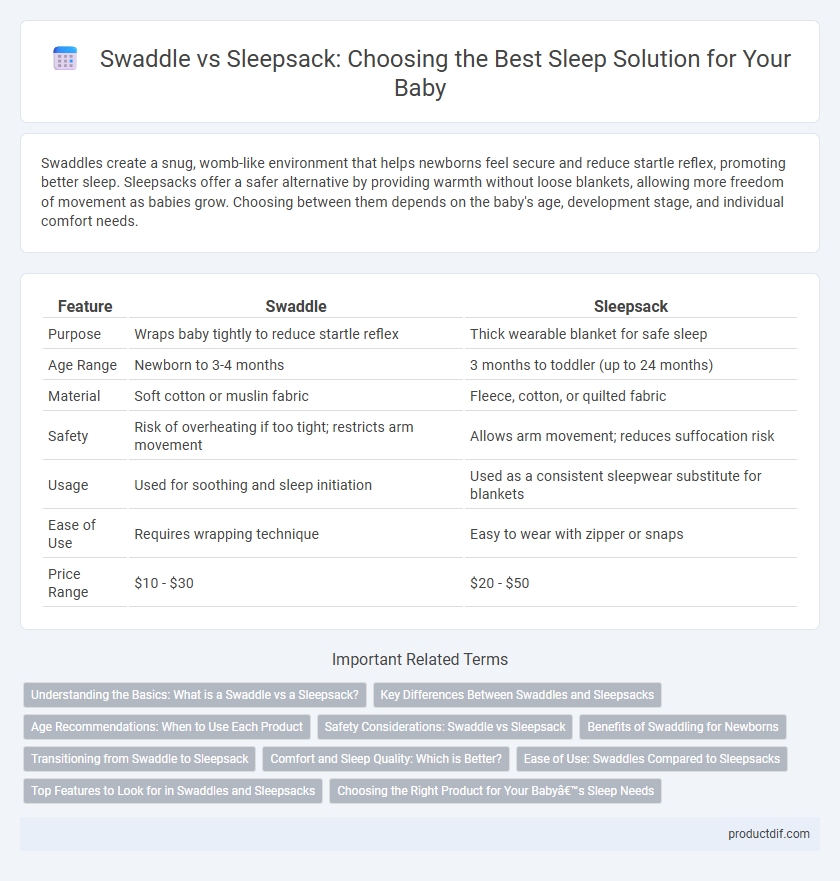Swaddles create a snug, womb-like environment that helps newborns feel secure and reduce startle reflex, promoting better sleep. Sleepsacks offer a safer alternative by providing warmth without loose blankets, allowing more freedom of movement as babies grow. Choosing between them depends on the baby's age, development stage, and individual comfort needs.
Table of Comparison
| Feature | Swaddle | Sleepsack |
|---|---|---|
| Purpose | Wraps baby tightly to reduce startle reflex | Thick wearable blanket for safe sleep |
| Age Range | Newborn to 3-4 months | 3 months to toddler (up to 24 months) |
| Material | Soft cotton or muslin fabric | Fleece, cotton, or quilted fabric |
| Safety | Risk of overheating if too tight; restricts arm movement | Allows arm movement; reduces suffocation risk |
| Usage | Used for soothing and sleep initiation | Used as a consistent sleepwear substitute for blankets |
| Ease of Use | Requires wrapping technique | Easy to wear with zipper or snaps |
| Price Range | $10 - $30 | $20 - $50 |
Understanding the Basics: What is a Swaddle vs a Sleepsack?
A swaddle is a lightweight fabric wrap designed to snugly encase a newborn, mimicking the womb environment to prevent startle reflex and promote restful sleep. A sleepsack, also known as a wearable blanket, is a zippered garment that keeps babies warm without the need for loose blankets, ensuring safety and comfort throughout the night. Both products aim to improve infant sleep quality but serve different needs based on the baby's age and mobility.
Key Differences Between Swaddles and Sleepsacks
Swaddles securely wrap infants, limiting arm movement to promote better sleep by mimicking the womb environment, while sleepsacks offer a wearable blanket that allows for freer arm movement, enhancing safety as babies grow. Swaddles are typically used for newborns to 3 months, whereas sleepsacks accommodate older infants and toddlers, providing a transition from swaddling to independent sleep. The choice between swaddle and sleepsack depends on the baby's age, developmental stage, and sleep safety needs.
Age Recommendations: When to Use Each Product
Swaddles are typically recommended for newborns up to 3 months old to provide a snug, womb-like environment that helps reduce startle reflex and promote better sleep. Sleepsacks are designed for older infants, usually from 3 months to 12 months, offering a safer alternative to loose blankets while allowing more freedom of movement as babies grow. Choosing the right product based on age ensures optimal comfort, safety, and sleep quality for your baby.
Safety Considerations: Swaddle vs Sleepsack
Swaddles restrict a baby's arm movement, which can reduce the startle reflex but may pose risks if improperly wrapped or if the baby rolls over, increasing the chance of suffocation. Sleepsacks provide a wearable blanket that allows free arm movement while keeping the baby warm, reducing the risk of overheating and suffocation associated with loose blankets. Both products should fit properly and be used according to age recommendations to ensure safe sleep environments and prevent Sudden Infant Death Syndrome (SIDS).
Benefits of Swaddling for Newborns
Swaddling provides newborns with a cozy, womb-like environment that helps reduce the startle reflex, promoting longer and more restful sleep. It supports healthy hip development by keeping the baby's legs in a natural, flexed position, reducing the risk of hip dysplasia. Swaddling also helps regulate infant temperature and soothes fussiness, aiding in overall baby comfort and better sleep patterns.
Transitioning from Swaddle to Sleepsack
Transitioning from swaddle to sleepsack is essential for promoting safe sleep as babies develop motor skills and begin to roll over. Unlike swaddles that restrict arm movement, sleepsacks offer breathable comfort while allowing freedom of movement, reducing the risk of overheating and Sudden Infant Death Syndrome (SIDS). Parents often choose sleepsacks to provide warmth and security during sleep without compromising safety during this crucial developmental phase.
Comfort and Sleep Quality: Which is Better?
Swaddles offer snug compression that mimics the womb, promoting a sense of security and reducing startle reflexes for improved sleep quality. Sleepsacks provide breathable, wearable blankets that allow more freedom of movement while maintaining warmth, reducing overheating risks and enhancing overall comfort. Choosing between swaddle and sleepsack depends on an infant's age, sleep habits, and preference for movement restriction or enhanced mobility.
Ease of Use: Swaddles Compared to Sleepsacks
Swaddles offer a snug, adjustable fit with Velcro or zipper closures that allow quick wrapping, making them highly convenient for newborns who prefer tightness. Sleepsacks provide a simpler, wearable blanket design with shoulder snaps or zippers, enabling faster diaper changes without fully undressing the baby. Parents often find swaddles slightly more challenging to master initially, while sleepsacks deliver consistent ease of use for nighttime routines.
Top Features to Look for in Swaddles and Sleepsacks
Key features to prioritize in swaddles and sleepsacks include breathable, soft fabrics like organic cotton or muslin that reduce overheating risks. Secure fastening systems such as Velcro or zipper designs ensure easy diaper changes and maintain a snug fit for safety and comfort. Consider sizing options that accommodate growth and allow for natural hip movement to support healthy infant development.
Choosing the Right Product for Your Baby’s Sleep Needs
Swaddles provide a snug, womb-like environment that can help soothe newborns and reduce the startle reflex, ideal for babies up to 3 months old. Sleepsacks offer a safer alternative to loose blankets, allowing more freedom of movement while maintaining warmth, suitable for older infants and toddlers. Selecting between swaddle and sleepsack depends on your baby's age, sleep patterns, and comfort preferences to ensure safe and restful sleep.
Swaddle vs Sleepsack Infographic

 productdif.com
productdif.com